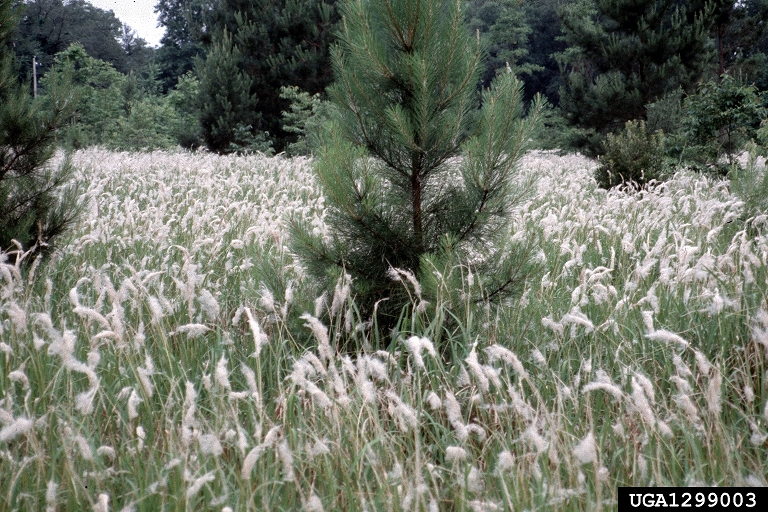
by Matt Lollar | Nov 4, 2021
Invasive species are all around us, from invasive plants like cogongrass to invasive amphibians like Cuban tree frogs to invasive insects like red imported fire ants. These species affect our ecosystems by outcompeting native species for nutrients or food and other precious resources. To help with the management of these noxious organisms, the October 2021 edition of Gardening in the Panhandle LIVE educated the public on invasive species. The highlights from the webinar are listed below.

Cogongrass dominating the landscape. Photo credit: Charles T. Bryson, USDA Agricultural Research Service, Bugwood.org.
Invasive Species Education
For general invasive species terminology please visit. Invasive Species Terminology: Standardizing for Stakeholder Education
Here’s a great resource to help educate the public about invasive plant species. Florida Invasive Plant Education Initiative
The University of Florida has developed a comprehensive list of invasive plant species. Assessment of Non-Native Plants in Florida’s Natural Areas
Invasive Species Control
Cogongrass Control: Cogongrass (Imperata cylindrica) Biology, Ecology, and Management in Florida Grazing Lands
Bamboo Control: Bamboo Control
Chinese Tallow (Popcorn Tree) Control: Natural Area Weeds: Chinese Tallow (Sapium sebiferum L.)
Armadillo Management: Baiting the Nine-Banded Armadillo
Dollarweed Control: Pennywort (Dollarweed) Biology and Management in Turf
Doveweed Control: Biology and Management of Doveweed (Murdannia Nudiflora) in Ornamental Crop Production
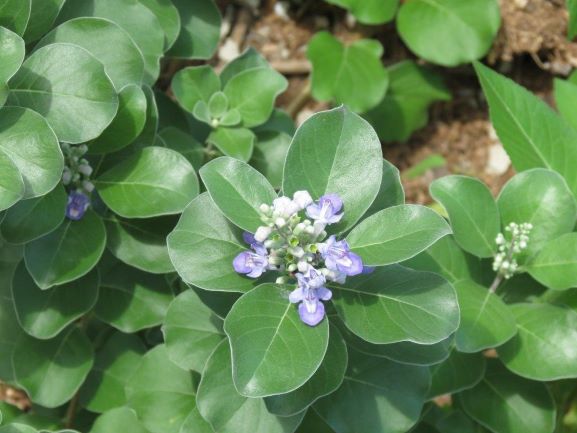
by Carrie Stevenson | May 27, 2021
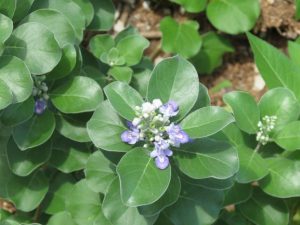
Beach vitex in bloom is an attractive plant, which can make it more difficult to convince property owners of its harmful potential. Photo credit: Rick O’Connor, Florida Sea Grant
One of the biggest problems with beach vitex (Vitex rotundifolia) is its beauty. It has rounded, deep green leaves (with a silvery gray cast) and a beautiful little lavender-purple bloom. Like most weedy invasive plants, the plant was imported and sold as an ornamental groundcover for many years. Homeowners and landscapers planted it in coastal areas where it is well adapted to the salt and heat, and no one realized it would be so problematic. Ever since, beach vitex took root and has continued growing, unchecked, throughout the coastal south.
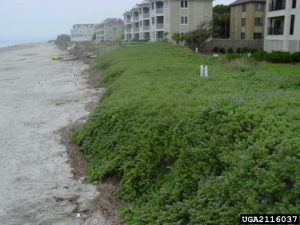
In this photo, beach vitex has overrun all native dune vegetation to form a monoculture. Photo credit: Randy Westbrook, Invasive Plant Control, Inc. bugwood.org
North and South Carolina started having big issues first, when beach vitex was planted deliberately to stabilize sand dunes after hurricanes. Soon after, a coastal restoration specialist with the Army Corps of Engineers realized the mistake. The vines run along the ground in such thick mats that native vegetation like sea oats can be choked out. The wide-spreading fibrous roots and tall profile of sea oats hold sand in place better than the beach vitex’s low growth and taproot, which have long term consequences for maintaining dune stability. The thick tangle of vitex growth is yet another obstacle for hatchling sea turtles in a long list of man-made problems that has made nesting and reproduction difficult.
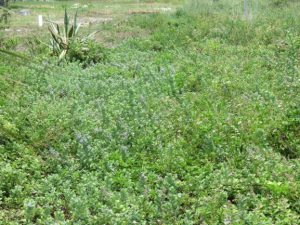
The invasive vine beach vitex has taken over a stretch of sand on Pensacola Beach. Photo credit: Rick O’Connor, Florida Sea Grant
Eradication of the noxious weed has proved difficult. When a plant gets the nickname, “beach kudzu,” you know something went seriously wrong. Beach vitex produces millions of seeds in late summer and early fall, which are dispersed by wind, birds, and float over water. Unless removed before going to seed, even a small patch of the vine can expand rapidly. While not as prevalent in Florida, over 80 sites have been identified in the western panhandle with beach vitex. Due to these problematic issues, the plant was recently added to the Florida Noxious Weed and Invasive Species List, making it illegal to sell, grow, move, or release the plant.
To learn more about how to identify, report, and remove beach vitex, visit www.eddmaps.org or contact Rick O’Connor at roc1@ufl.edu.
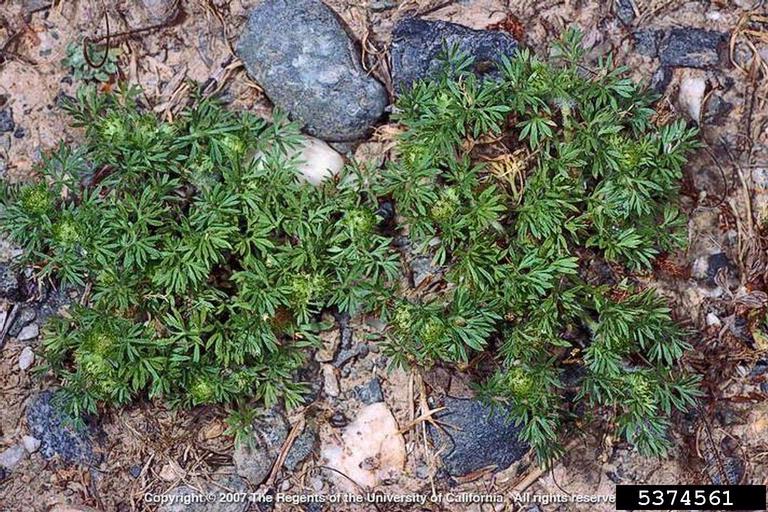
by Matthew Orwat | May 12, 2016
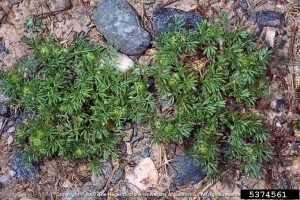
Burweed, Soliva Sessilis. – Image Credit: Joseph M. DiTomaso, University of California – Davis, Bugwood.org. Creative Commons License
This spring, lawn burweed has been an especially noticeable problem in lawns. Extension offices throughout Northwest Florida have been fielding many questions and finding solutions to lawn burweed infestations!
On the top of my list of lawn related annoyances is stepping into a patch of burweed, Soliva sessilis, which is in the sunflower family and is also known as spurweed. The leaves are opposite along the stem and sometimes resemble parsley. The main ways in which burweed can irk the casual gardener are sticking to socks, sneaking in with the dog, or littering flower beds with its nuisance. It can also hide in the house and reappear when shoes are removed. This causes pain in both the foot and the ear.
Aside from herbicides, maintaining a healthy vigorous lawn will prevent weeds from taking over. If your lawn is reasonably healthy and only a few instances of this weed exist, try to mechanically remove them and encourage the lawn to outgrow them.
If cultural methods aren’t sufficient, science has given us several options to control this irksome pest. Herbicides containing the active ingredients dicamba, 2,4-D or atrazine are good at controlling burweed as a post emergence control when applied from December through March. Be careful to use reduced rates on centipede and St. Augustine lawns, and never use more than the labeled rate since injury can occur when using these products on these species. Later applications have less effect on burweed because as it matures it is harder to control. Additionally the burs, once present on the lawn, are hard to remove. As the daytime temperatures rise to 90ºF, some of these herbicides may cause lawn damage. Try to keep the spray residue outside of the root zone of desirable plants to avoid injury and always follow label directions.
Be aware that burweed reproduces by seed, so mowing it down will only increase the problem by burying the seed for fall germination. Although we are now in the month of May, control of actively growing burweed might still be warranted if it is still flowering and setting seed. As temperatures warm up burweed will die, as it is a winter annual. In cases where it is already dying, control is not warranted since the natural cycle of winter annuals is concluding.
If an infestation of burweed has occurred this year, take note. The best time to apply pre-emergent herbicides to control burweed is in October. A widely used preemergence product for burweed control is isoxaben, which is sold under the brand name of Gallery as well as others. It prevents the weed from emerging from the ground when it germinates and can be used on St. Augustine, centipede, bahia and zoysia lawns, as well as in ornamental shrub beds. In northwest Florida, this herbicide needs to be applied in October for best results. A second application later in the season might be warranted. For more information about control, please consult this excellent article on lawn burweed management.
The active ingredients mentioned above are present in a variety of ‘trade name’ products* available from your local garden center, farm supply or co-op. Be sure to read label instructions carefully and contact your local extension office for any assistance. I hope all the northwest Florida lawn managers prevent burweed during the upcoming fall so that lawns will be burweed free next spring.
Happy Gardening!
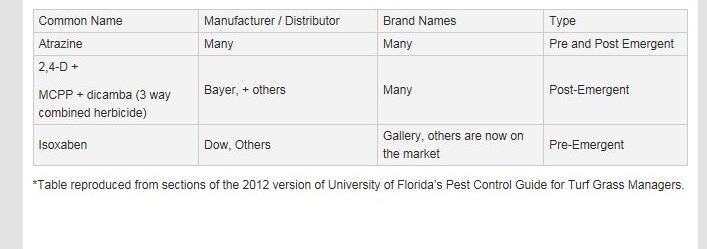
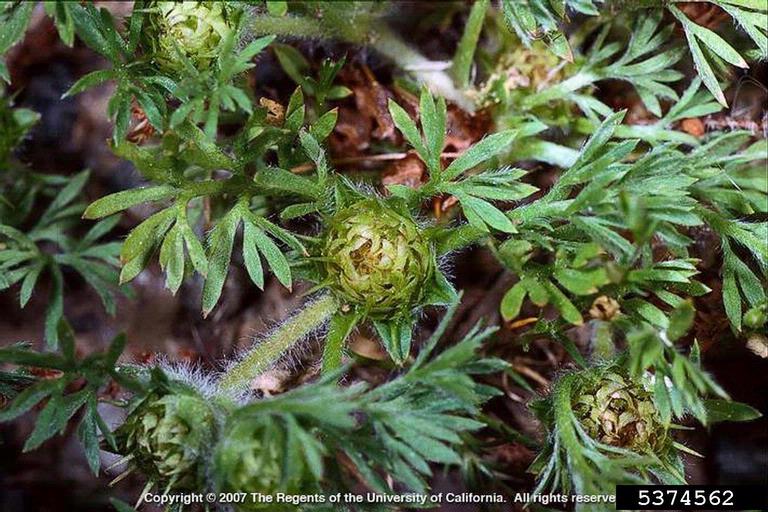
by Matthew Orwat | Oct 6, 2015
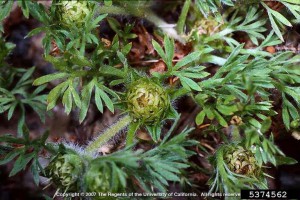
Lawn Burweed, Soliva Sessilis, Closeup – Image Credit: Joseph M. DiTomaso, University of California – Davis, Bugwood.org, Create Commons License
On this bright and sunny early fall morning I was thinking about all of the great gardening opportunities the cooler fall weather is bringing us in the Florida Panhandle. However, my thoughts drifted to the annoyances that the gardeners find when trying to enjoy their lawn or garden.
On the top of my list is stepping into a patch of burweed, which is in the sunflower family and is also known as spurweed. The leaves are opposite along the stem and sometimes resemble parsley. The main ways which burweed can irk the casual gardener are sticking to socks, sneaking in with the dog, or littering flower beds with its nuisance. It can also hide in the house and reappear when shoes are removed. This causes pain in both the foot and the ear.
Aside from herbicides, maintaining a healthy vigorous lawn will prevent weeds from taking over. If you lawn is reasonably healthy and only a few instances of this weed exist, try to mechanically remove them and encourage the lawn to outgrow them.
If cultural methods aren’t sufficient, science has given us several options to control this irksome pest. A widely used pre-emergence product for burweed control is isoxaben, which is sold under the brand name of Gallery as well as others. It prevents the weed from emerging from the ground when it germinates and can be used on St. augustine, centipede, bahia and zoysia lawns, as well as ornamental shrub beds. In northwest Florida, this herbicide needs to be applied in October for best results.

Burweed, Soliva Sessilis. – Image Credit: Joseph M. DiTomaso, University of California – Davis, Bugwood.org. Creative Commons License
Herbicides which contain the active ingredients dicamba, 2,4-D or atrazine are good at controlling burweed as a post emergence control when applied from December through early March. Be careful to use reduced rates on centipede and St. augustine lawns, and never use more than the labeled rate. Later applications have less effect on burweed because as it matures it is harder to control. Additionally the burs, once present on the lawn, are hard to remove. As the daytime temperatures get a few degrees over 80, some of these herbicides may cause lawn damage so immediate application is advised. Try to keep the spray residue outside of the root zone of desirable plants to avoid injury and always follow label directions. Be aware that burweed reproduces by seed, so mowing it down will only increase the problem by burying the seed for fall germination.
The active ingredients mentioned above are present in a variety of ‘trade name’ products* available from your local garden center, farm supply or CO-OP. I hope all the northwest Florida lawns prevent burweed so that the spring lawns will be burweed free. Happy Gardening!
| Common Name |
Manufacturer / Distributor |
Brand Names |
Type |
| Atrazine |
Many |
Many |
Pre and Post Emergent |
| 2,4-D +
MCPP + dicamba (3 way combined herbicide) |
Bayer, + others |
Many |
Post-Emergent |
| Isoxaben |
Dow, Others |
Gallery, others are now on the market |
Pre-Emergent |
*Table reproduced from sections of the 2012 version of University of Florida’s Pest Control Guide for Turf Grass Managers.
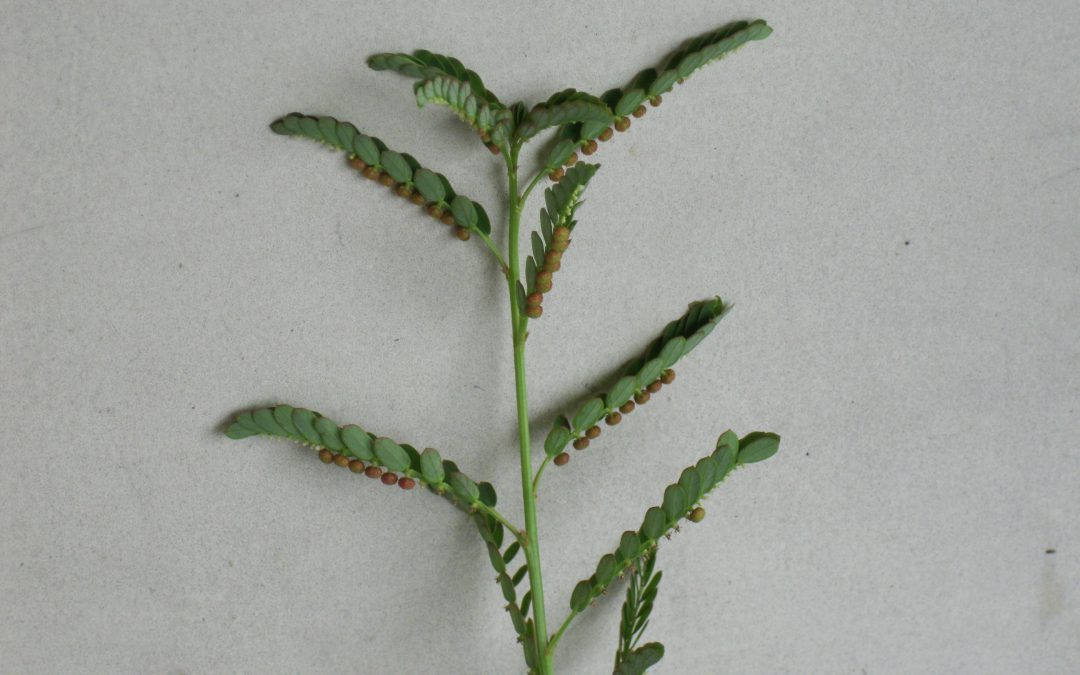
by Julie McConnell | Aug 5, 2013
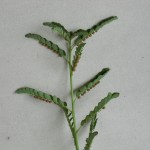
Chamberbitter
Above average rainfall this summer has supplied water to more than just our landscapes, weeds are benefiting and flourishing as well.
Just as with any other landscape pest, proper weed control starts with accurate identification and knowledge about the life cycle of the weed.
When weeds are low in number, mechanical control (pulling, mowing) is a good start. If weed population continues to increase and herbicide options are considered, several questions need to be answered before product application.
Questions you need to ask yourself about your weed and site:
- What weed(s) are you trying to control?
o Be sure you know what the name of the weed is so that you can find it on your product label “weeds controlled” list; if you need help with identification contact your local county extension office
- What is your site?
o Lawn – specific turfgrass is important, what is safe to use on one type may kill another
o Ornamental beds – again note specific plants near your treatment area in case of sensitivity
o Water bodies – some herbicides are not labeled for use within a given distance of water; if the weed is in or around the water only use herbicides listed for aquatic weed control
- What is the life cycle of your weed?
o Annual – one season life cycle, summer annuals complete their life cycle between spring and fall; winter annuals are active between fall and spring
o Biennial – two growing season life cycle
o Perennial – plant lives for three or more years
- What category does your weed fall into?
o Grasses – one seed leaf as it emerges from the soil; hollow, rounded, stems with nodes, parallel veins in true leaves; examples are crabgrass, dallisgrass, cogongrass, torpedograss
o Broadleaves – have two seed leaves and true leaves have net-like veins and usually have showy flowers; examples are lespedeza, dollarweed, clover, chickweed, henbit, florida betony
o Sedges/Rushes – sedges have solid triangular stems; rushes have round stems; both like moist or wet habitat; examples are purple nutsedge, yellow nutsedge, beak rush
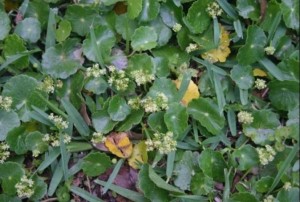
Dollarweed: Image Credit Edis ENH1128
Basic information about herbicide categories:
For more information read EDIS Publication “Weed Management in Home Lawns”















